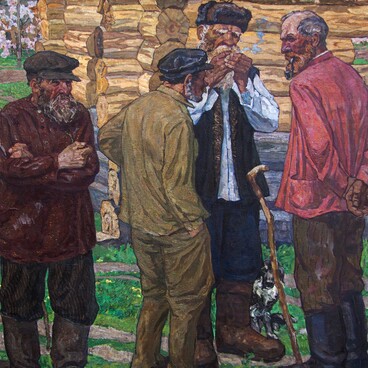In the late 1970s, there was a shift in artistic traditions of Soviet fine art. The achievements of the previous decades became the starting point for new creative experiments. Artists of this time turned to folklore and traditions of Russian and European art of different centuries. This period was the heyday of the national schools of Central Asia, Transcaucasia, Belarus and Ukraine, and artists were looking for new ways to express their national identity.
An original world of images was created by the artist Galina Stapan. She was born in 1946, and graduated from the Ryazan Art College in 1967. She traveled extensively in Central Asia. Galina Stapan was actively engaged in female portraiture: among her famous paintings, the images of Moksha women are particularly interesting, those include “Lukerya Ivanovna”, “Grandmother”, and “Pelageya”. “The image of a woman’s soul” is the title of one of the articles dedicated to the artist’s work.
A city dweller, she discovered the world of the Mordovian rural hinterland. Impressed by one of her creative trips, the artist created the series “Haymaking” about living in harmony with civilization and nature.
The canvas “Evening. Meadows of Moksha River” was part of the series. The picture turned out to be heartfelt and lyrical, it evokes various associations and there is subtle spirituality in it. On the one hand, the work was consonant with the artist’s emotions, on the other, it was in tune with the atmosphere of that time which called for intimate confessions.
The heroines of the painting seem to have descended from the canvases of Renaissance artists, and at the same time they harmoniously merge with the expanses of the Volga region, which, in turn, seem to be woven from a heavenly haze. The figures of five girls are depicted against the background of soft rounded hills and the evening sky. Smooth lines and delicate lilac, blueish-green and yellow shades create a contemplative mood.
Using the conventionality of the landscape, the softness of the color palette and the subtle balance of tones, the artist emphasized the timeless ideal of female beauty. Thanks to the generalized and stylized image, the image of the Mordovian girls is perceived as an allegory and a reference to the best examples of fine art.
An original world of images was created by the artist Galina Stapan. She was born in 1946, and graduated from the Ryazan Art College in 1967. She traveled extensively in Central Asia. Galina Stapan was actively engaged in female portraiture: among her famous paintings, the images of Moksha women are particularly interesting, those include “Lukerya Ivanovna”, “Grandmother”, and “Pelageya”. “The image of a woman’s soul” is the title of one of the articles dedicated to the artist’s work.
A city dweller, she discovered the world of the Mordovian rural hinterland. Impressed by one of her creative trips, the artist created the series “Haymaking” about living in harmony with civilization and nature.
The canvas “Evening. Meadows of Moksha River” was part of the series. The picture turned out to be heartfelt and lyrical, it evokes various associations and there is subtle spirituality in it. On the one hand, the work was consonant with the artist’s emotions, on the other, it was in tune with the atmosphere of that time which called for intimate confessions.
The heroines of the painting seem to have descended from the canvases of Renaissance artists, and at the same time they harmoniously merge with the expanses of the Volga region, which, in turn, seem to be woven from a heavenly haze. The figures of five girls are depicted against the background of soft rounded hills and the evening sky. Smooth lines and delicate lilac, blueish-green and yellow shades create a contemplative mood.
Using the conventionality of the landscape, the softness of the color palette and the subtle balance of tones, the artist emphasized the timeless ideal of female beauty. Thanks to the generalized and stylized image, the image of the Mordovian girls is perceived as an allegory and a reference to the best examples of fine art.


